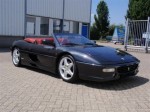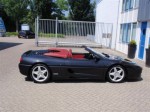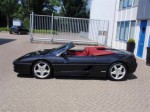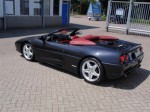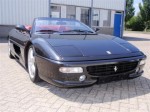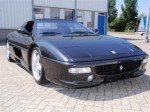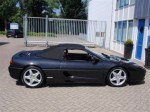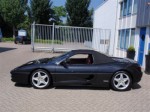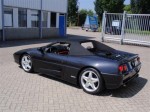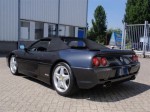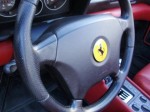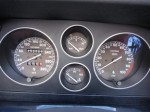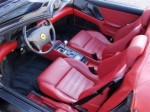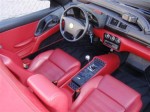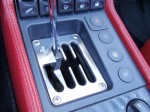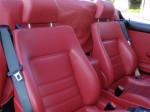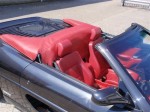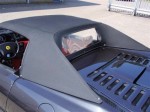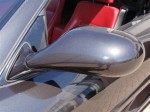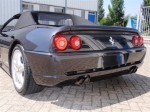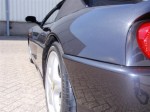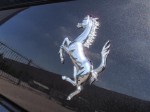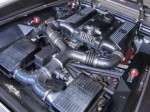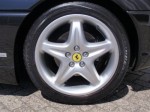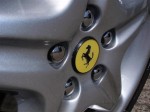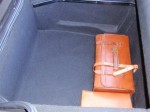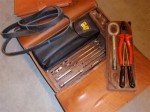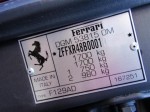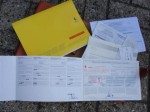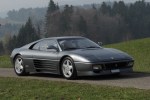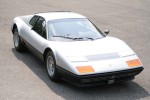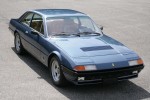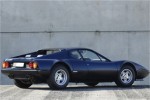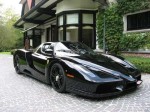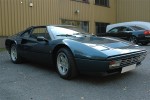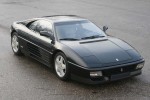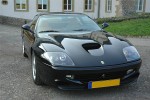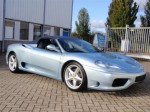1996 Ferrari F355 spider
- 1996
- 53.000 km
- Original
- EU title
- EU taxes paid
- Sold
This Ferrari F355 Spider has been sold to a lady driver in Germany.
The 355 out-performs any previous Ferrari with an 8-cylinder normally aspirated engine. This meant designing an aesthetic body to the highest aerodynamic specifications.
On the one hand the designers had to achieve a front and rear Cz to match the car's performance. At the same time they had to ensure that the flow of cooling air would meet the requirements of the power of the engine.
The front bumper incorporates an air intake that cools the brake discs; while the spoiler, area was shaped to optimise the airflow channelled into the underbody for negative lift.
On the sides, the air ducts are generous and merge into the aerodynamically shaped sills, which contribute to fairing the wheel wells, an important element on a car fitted with wide section tyres.
At the rear, wind tunnel experiments have produced a forceful tail profile, which incorporates a nolder to enhance grip. The 18 inch wheels offer a dynamic sculpture-like interpretation of the classic, 5-spoke arrangement.
This Pininfarina design successfully blends the latest Ferrari styling trends including two round rear lights in a broad body-colour strip.
The array of instruments is kept to the strictly essential and the controls are much in the style of earlier Ferrari models. Auxiliary instruments are clustered together on a central board and the classic Ferrari switches are close at hand near the gear lever.
The latter adopts an aluminium knob and a traditional Ferrari gate. The body is a two-seater Berlinetta in aluminium and steel, designed by Pininfarina. The design of the body took over 1800 hours of wind tunnel analysis.
The shape incorporates all those ideas generated by experimentation and is aimed at maximising both aerodynamic efficiency and stability while meeting the technical requirements of performance.
Having achieved an optimal Cd, research concentrated on optimising vertical loads on the wheels. This was done by analysing the factors effecting the front spoiler and rear bonnet to create an ideal shape.
This stage also involved analysis of the underbody and the creation of a floor-pan shape that made the distribution of the aerodynamic load independent of ground clearance.
In-depth analysis was devoted to internal airflows, and the air vents that cool the side radiators and the brakes were designed with great care. The result is a better flow of air to maintain an ideal temperature in all elements even in sports/race track conditions.
The cabin was designed to maximise both driving pleasure and safety. In accordance with established Ferrari tradition the driving position, obtained with an all-adjustable driver's seat and a height-adjustable steering wheel, is considered a vital factor.
The Ferrari 355 has comfortable, body-hugging seats upholstered in Connolly leather with electronically assisted adjustments. The lever for the six-speed gearbox is positioned on the tunnel for optimum manoeuvrability.
The layout of controls and instruments was also carefully designed to ensure that all are within easy reach of eye and hand. The use of adjustable suspension settings also helps to enhance the overall efficiency of the car's active safety system.
On the comfort side, an ideal cabin climate has been created by achieving a perfect balance between the speed and distribution of airflows from the heating/ventilation system.
The air conditioner operates on environment-friendly R134A gas. The 220 litre front boot is designed to hold a tool kit and a set of three optionally available suitcases.
The Ferrari F355 adopts a stress-bearing frame of welded variable section steel tubes a tubular subframe that holds the engine and suspension assemblies.
The layout adopts the racing model format with a central stree-bearing shell to which the engine assembly and suspension are attached. The monocoque construction technology also involved the use of sophisticated laser welding techniques for the double thickness sheet steel.
This means that torsional and bending rigidity can be enhanced while reducing weight. The independent suspension system adopts unequal length non-parallel wishbones with springs and aluminium gas dampers plus anti-roll bars.
The Ferrari F 355 incorporates a damping management system with two different programmes. Within each programme, damping force varies on the basis of vehicle speed.
An electronic control unit adjusts the system automatically in order to adapt the vehicles response to each new situation. This involves two sensors that transmit the figures for longitudinal, vertical and lateral acceleration to the control unit where they are instantly processed and converted into a damping variation. Rack and pinion power steering is standard.
The braking system adopts four self-ventilated discs with 4-cylinder aluminium calipers. The ATE ABS can be cut out as necessary. The wheels are 18 inch with magnesium rims. These combined with the aluminium dampers, brake calipers and wheel covers to lighten the unsprung masses in a way that further enhances roadholding and performance.
The tyres were developed in collaboration with the manufacturers for even greater stability and grip without detriment to comfort, handling and safety. Particular care was taken to enhance the tyre's capacity to absorb bumps in the road surface and over the careful design of a noise-reducing tread.
The new directional design of the front tyres makes for optimum safety in hydroplaning conditions. The rear tyres feature a new asymmetric tread design to ensure that traction and braking are on a par with the vehicle's performance. The fuel tank is in light alloy.
For the F355, Ferrari developed a new 90-degree V-8 3495cc engine with a 85mm x 77mm bore and stroke. This power unit develops 380 bhp at 8500 rpm. Its maximum torque is 268lb/ft at 6000 rpm. At 109 bhp/litre, this engine develops the highest specific power for a normally aspirated Ferrari engine.
Timing is by four overhead cams with tapered lateral intake cam valves designed especially for Ferrari and five valves per cylinder. In order to reduce exhaust emissions and maintenance flexibility, hydraulic tappets with automatic play take-up appear for the first time on engines capable of over 8000 rpm.
In addition, the variable rigidity-valve double springs raise the resonance potential state to over 10.000 rpm. The cylinder head layout of the F355 derives from Ferraris long experience in Formula 1.
The Ferrari engineers have created an extremely compact high-swirl combustion chamber with an 11:1 compression ratio. The creation of a 15 degree 30 min - 22 degree 30 min angle is also significant here.
The use of five valves per cylinder makes it possible to combine high revs with high intake permeability in a way that maximises overall engine efficiency. The pistons are made of a forged aluminium alloy with a distinctly lower than average apparent density K=0.44 and are coupled with Nicasil-coated wet steel liners. These are wet-sunk into he aluminium engine block.
For optimum engine efficiency at high speeds the Ferrari 355 adopts Ti6a14V titanium alloy, finite element-designed conrods previously seen only on Ferrari Formula 1 engines. The F355 also features Bosch Motronic M2.7 electronic injection/ignition management.
The dry sump engine oil circuit incorporates twin scavenge and one pressure pump plus a thermostatic control valve.
The intake system draws in air through the upper side ducts, each of which feeds its own intake duct. This ensures a dynamic supply of air at ambient temperature for optimum engine performance even in very hot weather. In addition, load losses are minimised by the use of two large filter panels.
The Bosch M2.7 twin-injection system adopts hot wire airflow meters. The intake ducts feature an extra-large internal volume and progressively tapered duct.
The intake manifolds adopt single throttles with evolving profile to ensure prompt engine response combined with smoothly progressive performance at partial-throttle. The exhaust system is in insulated stainless steel with 4-2-1 manifolds for each cylinder bank.
The system features a twin-branch delivery to the catalysts: one main branch to a ceramic matrix catalyst and one by-pass branch to steel matrix catalysts. The by-pass branch only comes into play at high speeds in response to the opening of a throttle valve controlled by the Motronic system.
This optimises engine performance by reducing exhaust backpressure. The on-board diagnostics conform to the toughest of the current regulations.
The new transverse gearbox offers six speeds plus reverse, all synchronised and with a shorter engagement travel. Ratios are designed to make the most of the torque curve, hereby enhancing the driveability and sporty performance of the car.
The gear shifter adopts a lever, which actuates a rigid rod and the turret is fitted with sliding ball sleeves. The differential is multi-plate limited slip type with a segmented lock that adopts a differentiated drive and overrun.
The single 9 ¾ dry plate clutch is hydraulically actuated. The clutch housing is made of magnesium alloy. A water/oil heater exchanger ensures that the gearbox oil is rapidly brought to the correct operating temperature.
“ your classic auto specialist; world-wide collector car expertise ”
We buy, sell, broker, locate, consign and appraise exceptional classic, sports and collector automobiles, arrange transport, customs formalities and registration.
Jaguar, Ferrari and Maserati expertise, though our collection includes a wide variety of other superior antique, vintage, prewar and race cars.
Contact us when you are serious about owning or selling a fine classic motor car or motorcycle. Geneva, Switzerland-based, we serve clients world-wide.
Chemin des Tulipiers | 1208 | Geneva | Switzerland | +41 (0) 787.055.745
